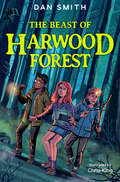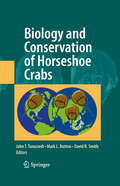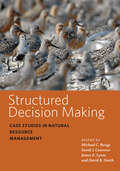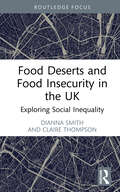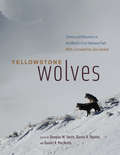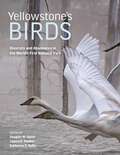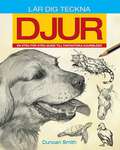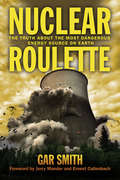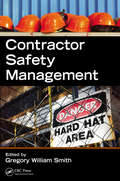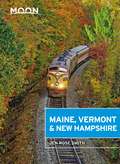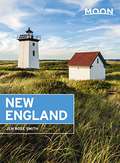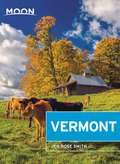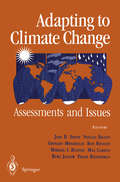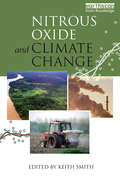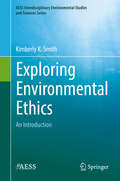- Table View
- List View
The Crooked Oak Mysteries (The Crooked Oak Mysteries #2)
by Dan SmithPete, Nancy and Krish's school camping trip takes a turn for the sinister when they uncover a terrifying mystery … A page-turning thriller for fans of the supernatural from bestselling author Dan Smith.
Biology and Conservation of Horseshoe Crabs
by David Smith Mark L. Botton John T. TanacrediHorseshoe crabs, those mysterious ancient mariners, lured me into the sea as a child along the beaches of New Jersey. Drawn to their shiny domed shells and spiked tails, I could not resist picking them up, turning them over and watching the wondrous mechanical movement of their glistening legs, articulating with one another as smoothly as the inner working of a clock. What was it like to be a horseshoe crab, I wondered? What did they eat? Did they always move around together? Why were some so large and others much smaller? How old were they, anyway? What must it feel like to live underwater? What else was out there, down there, in the cool, green depths that gave rise to such intriguing creatures? The only way to find out, I reasoned, would be to go into the ocean and see for myself, and so I did, and more than 60 years later, I still do.
Structured Decision Making: Case Studies in Natural Resource Management (Wildlife Management and Conservation)
by David R. SmithWhen faced with complicated, potentially controversial decisions that affect our environment, many resource management agencies have come to realize the value of structured decision making (SDM)—the systematic use of principles and tools of decision analysis. Few professionals, however, have extensive experience implementing SDM. Structured Decision Making provides key information to both current adopters of the method and those who are deploying it for the first time by demonstrating the formal use of decision analysis to support difficult, real-world natural resource management decisions. Drawing on case studies from multiple public agencies in the United States, Canada, Australia, and Mauritius, the editors present an overview of decision analysis, a classification of decision types, and a catalog of decision analysis methods. Dozens of detailed charts and maps help contextualize the material. These case studies examine a rich variety of topics, including• keeping forest birds free from disease• conserving imperiled freshwater mussels• managing water for oil sands mining• dealing with coastal wetlands in the face of sea-level rise• designing networks for prairie-dependent taxa• combatting invasive alpine shrubs• managing vernal pool habitats for obligate amphibian species • and much moreAimed at decision makers tackling natural resource challenges in government agencies around the world, as well as advanced undergraduate and graduate students preparing to work in natural resource management, Structured Decision Making shows how SDM can be implemented to achieve optimal outcomes that integrate social values and scientific understanding.Contributors: Taber D. Allison, Larissa L. Bailey, Ellen A. Bean, Clint W. Boal, Gregory Breese, Stefano Canessa, Jean Fitts Cochrane, Sarah J. Converse, Cami S. Dixon, John G. Ewen, Christelle Ferrière, Jill J. Gannon, Beth Gardner, Adam W. Green, Justin A. Gude, Victoria M. Hunt, Kevin S. Kalasz, Melinda G. Knutson, Jim Kraus, Graham Long, Eric V. Lonsdorf, James E. Lyons, Conor P. McGowan, Sarah E. McRae, Michael S. Mitchell, Clinton T. Moore, Joslin L. Moore, Steven Morey, Dan W. Ohlson, Charlie Pascoe, Andrew Paul, Eben H. Paxton, Lori B. Pruitt, Michael C. Runge, Sarah N. Sells, Terry L. Shaffer, Stephanie Slade, David R. Smith, Jennifer A. Szymanski, Terry Walshe, Nicolas Zuël
Structured Decision Making: Case Studies in Natural Resource Management (Wildlife Management and Conservation)
by David R. SmithWhen faced with complicated, potentially controversial decisions that affect our environment, many resource management agencies have come to realize the value of structured decision making (SDM)—the systematic use of principles and tools of decision analysis. Few professionals, however, have extensive experience implementing SDM. Structured Decision Making provides key information to both current adopters of the method and those who are deploying it for the first time by demonstrating the formal use of decision analysis to support difficult, real-world natural resource management decisions. Drawing on case studies from multiple public agencies in the United States, Canada, Australia, and Mauritius, the editors present an overview of decision analysis, a classification of decision types, and a catalog of decision analysis methods. Dozens of detailed charts and maps help contextualize the material. These case studies examine a rich variety of topics, including• keeping forest birds free from disease• conserving imperiled freshwater mussels• managing water for oil sands mining• dealing with coastal wetlands in the face of sea-level rise• designing networks for prairie-dependent taxa• combatting invasive alpine shrubs• managing vernal pool habitats for obligate amphibian species • and much moreAimed at decision makers tackling natural resource challenges in government agencies around the world, as well as advanced undergraduate and graduate students preparing to work in natural resource management, Structured Decision Making shows how SDM can be implemented to achieve optimal outcomes that integrate social values and scientific understanding.Contributors: Taber D. Allison, Larissa L. Bailey, Ellen A. Bean, Clint W. Boal, Gregory Breese, Stefano Canessa, Jean Fitts Cochrane, Sarah J. Converse, Cami S. Dixon, John G. Ewen, Christelle Ferrière, Jill J. Gannon, Beth Gardner, Adam W. Green, Justin A. Gude, Victoria M. Hunt, Kevin S. Kalasz, Melinda G. Knutson, Jim Kraus, Graham Long, Eric V. Lonsdorf, James E. Lyons, Conor P. McGowan, Sarah E. McRae, Michael S. Mitchell, Clinton T. Moore, Joslin L. Moore, Steven Morey, Dan W. Ohlson, Charlie Pascoe, Andrew Paul, Eben H. Paxton, Lori B. Pruitt, Michael C. Runge, Sarah N. Sells, Terry L. Shaffer, Stephanie Slade, David R. Smith, Jennifer A. Szymanski, Terry Walshe, Nicolas Zuël
Food Deserts and Food Insecurity in the UK: Exploring Social Inequality (Routledge Focus on Environment and Sustainability)
by Dianna Smith Claire ThompsonThis book examines the social inequalities relating to food insecurity in the UK, as well as drawing parallels with the US. Access to food in the UK, and especially access to healthy food, is a constant source of worry for many in this wealthy country. Crises, such as the COVID-19 pandemic, have coincided with a steep rise in the cost of living, meaning household food insecurity has become a reality for many more households. This book introduces a new framework to examine the many influences on local-level food inequalities, whether they result from individual circumstances or where a person lives. The framework will allow researchers new to the field to consider the many influences on food security, and to support emerging research around different sub-topics of food access and food security. Providing a thorough background to two key concepts, food deserts and food insecurity, the book documents the transition from area-based framing of food resources, to approaches which focus on household food poverty and the rise of food banks. The book invites researchers to acknowledge and explore the ever changing range of place-based factors that shape experiences of food insecurity: from transport and employment to rural isolation and local politics. By proposing a new framework for food insecurity research and by drawing on real-world examples, this book will support academic and applied researchers as they work to understand and mitigate the impacts of food insecurity in local communities. This book will be of great interest to students and scholars of food and nutrition security, public health, and sociology. It will also appeal to food policy professionals and policymakers who are working to address social inequalities and improve access to healthy and nutritious food for all.
Food Deserts and Food Insecurity in the UK: Exploring Social Inequality (Routledge Focus on Environment and Sustainability)
by Dianna Smith Claire ThompsonThis book examines the social inequalities relating to food insecurity in the UK, as well as drawing parallels with the US. Access to food in the UK, and especially access to healthy food, is a constant source of worry for many in this wealthy country. Crises, such as the COVID-19 pandemic, have coincided with a steep rise in the cost of living, meaning household food insecurity has become a reality for many more households. This book introduces a new framework to examine the many influences on local-level food inequalities, whether they result from individual circumstances or where a person lives. The framework will allow researchers new to the field to consider the many influences on food security, and to support emerging research around different sub-topics of food access and food security. Providing a thorough background to two key concepts, food deserts and food insecurity, the book documents the transition from area-based framing of food resources, to approaches which focus on household food poverty and the rise of food banks. The book invites researchers to acknowledge and explore the ever changing range of place-based factors that shape experiences of food insecurity: from transport and employment to rural isolation and local politics. By proposing a new framework for food insecurity research and by drawing on real-world examples, this book will support academic and applied researchers as they work to understand and mitigate the impacts of food insecurity in local communities. This book will be of great interest to students and scholars of food and nutrition security, public health, and sociology. It will also appeal to food policy professionals and policymakers who are working to address social inequalities and improve access to healthy and nutritious food for all.
Yellowstone Wolves: Science and Discovery in the World's First National Park (America's Animal Comebacks Ser.)
by Douglas W. Smith Daniel R. Stahler Daniel R. MacNultyIn 2020, it will have been twenty-five years since one of the greatest wildlife conservation and restoration achievements of the twentieth century took place: the reintroduction of wolves to the world’s first national park, Yellowstone. Eradicated after the park was established, then absent for seventy years, these iconic carnivores returned to Yellowstone in 1995 when the US government reversed its century-old policy of extermination and—despite some political and cultural opposition—began the reintroduction of forty-one wild wolves from Canada and northwest Montana. In the intervening decades, scientists have studied their myriad behaviors, from predation to mating to wolf pup play, building a one-of-a-kind field study that has both allowed us to witness how the arrival of top predators can change an entire ecosystem and provided a critical window into impacts on prey, pack composition, and much else. Here, for the first time in a single book, is the incredible story of the wolves’ return to Yellowstone National Park as told by the very people responsible for their reintroduction, study, and management. Anchored in what we have learned from Yellowstone, highlighting the unique blend of research techniques that have given us this knowledge, and addressing the major issues that wolves still face today, this book is as wide-ranging and awe-inspiring as the Yellowstone restoration effort itself. We learn about individual wolves, population dynamics, wolf-prey relationships, genetics, disease, management and policy, newly studied behaviors and interactions with other species, and the rippling ecosystem effects wolves have had on Yellowstone’s wild and rare landscape. Perhaps most importantly of all, the book also offers solutions to ongoing controversies and debates. Featuring a foreword by Jane Goodall, beautiful images, a companion online documentary by celebrated filmmaker Bob Landis, and contributions from more than seventy wolf and wildlife conservation luminaries from Yellowstone and around the world, Yellowstone Wolves is a gripping, accessible celebration of the extraordinary Yellowstone Wolf Project—and of the park through which these majestic and important creatures once again roam.
Yellowstone’s Birds: Diversity and Abundance in the World’s First National Park
by Douglas W. Smith Lauren E. Walker Katharine E. Duffy Robert K. LandisA beautifully illustrated survey of Yellowstone’s breathtaking birdlife, written by a team of renowned ornithologists and wildlife biologistsEstablished in 1872, Yellowstone National Park is the oldest and arguably the most famous national park in North America, attracting millions of visitors each year. While many come to the park for its recreational activities, the wildlife of Yellowstone is just as alluring. This book brings together more than 30 leading experts to provide the first comprehensive survey of the natural history, science, and conservation of birds in Yellowstone. Covering most bird species breeding within the great park as well as the many migrants that pass through, Yellowstone’s Birds is a scientific tour de force and an essential resource for visitors to Yellowstone and bird lovers everywhere.Tallies more than 200 species, including migrantsDescribes the natural history, status, and latest science on the birds of YellowstoneFeatures fact-filled, easy-to-read chapters, informative sidebar essays, maps, infographics, and photos that present current science in an easily understood wayAccompanied by videos by award-winning cinematographer Bob LandisDraws on a wealth of data on Yellowstone’s birds collected over many decadesWith contributions by many of today’s leading bird experts, this is a long-overdue survey of Yellowstone’s breathtaking avian fauna
The Fundamentals of Drawing Animals: A step-by-step guide to creating eye-catching artwork
by Duncan SmithFull of character and endlessly varied, our furry friends are great fun to draw. In this inspirational book, professional artist and animal-lover Duncan Smith shows how to create convincing drawings of a wide array of species, from domestic pets to farmyard animals, wild beasts and birds. Whether you are a complete novice or whether you want to take your animal portraits to the next level, The Fundamentals of Drawing Animals will show you how to get the most out of this enjoyable activity.
Lär Dig Teckna Djur: En steg-för-steg-guide till fantastiska djurbilder
by Duncan SmithDet är kul att teckna djur! Duncan Smith, konstnär och tecknare, visar hur man fångar karaktären, formen och strukturen hos en lång rad djur, alltifrån våra sällskapsdjur till bondgårdens djur, vilda djur och fåglar. Alla kan lära sig att teckna djur. Vare sig du är nybörjare eller enbart vill förbättra dina färdigheter i att teckna djurporträtt kommer Lär dig teckna djur att visa hur du får ut det mesta av denna givande hobby.
Nuclear Roulette: The Truth about the Most Dangerous Energy Source on Earth
by Gar Smith Ernest Callenbach Jerry ManderNuclear power is not clean, cheap, or safe. With Three Mile Island, Chernobyl, and Fukushima, the nuclear industry's record of catastrophic failures now averages one major disaster every decade. After three US-designed plants exploded in Japan, many countries moved to abandon reactors for renewables. In the United States, however, powerful corporations and a compliant government still defend nuclear power-while promising billion-dollar bailouts to operators. Each new disaster demonstrates that the nuclear industry and governments lie to "avoid panic," to preserve the myth of "safe, clean" nuclear power, and to sustain government subsidies. Tokyo and Washington both covered up Fukushima's radiation risks and-when confronted with damning evidence-simply raised the levels of "acceptable" risk to match the greater levels of exposure. Nuclear Roulette dismantles the core arguments behind the nuclear-industrial complex's "Nuclear Renaissance." While some critiques are familiar-nuclear power is too costly, too dangerous, and too unstable-others are surprising: Nuclear Roulette exposes historic links to nuclear weapons, impacts on Indigenous lands and lives, and the ways in which the Nuclear Regulatory Commission too often takes its lead from industry, rewriting rules to keep failing plants in compliance. Nuclear Roulette cites NRC records showing how corporations routinely defer maintenance and lists resulting "near-misses" in the US, which average more than one per month. Nuclear Roulette chronicles the problems of aging reactors, uncovers the costly challenge of decommissioning, explores the industry's greatest seismic risks-not on California's quake-prone coast but in the Midwest and Southeast-and explains how solar flares could black out power grids, causing the world's 400-plus reactors to self-destruct. This powerful exposé concludes with a roundup of proven and potential energy solutions that can replace nuclear technology with a "Renewable Renaissance," combined with conservation programs that can cleanse the air, and cool the planet.
Contractor Safety Management
by Gregory W. SmithA Winner of the Educational Award by the World Safety OrganizationContractor safety management is often seen as nothing more than a subset of general safety management in that no special consideration needs to be given to understanding the difficulties of the contract environment. This leaves contractors endlessly juggling competing and someti
Management Obligations for Health and Safety
by Gregory W. SmithIn recent years, the safety management field has placed leadership and commitment at the center of effective workplace health and safety programs. At the same time, personal liability for workplace health and safety has increased, resulting in poor outcomes for individual managers. Discussing the minimum expectations that courts and tribunals have
Routledge Handbook of Ocean Resources and Management (Routledge Environment and Sustainability Handbooks)
by Hance D. Smith Tundi S. Agardy Juan Luis Suárez de ViveroThis comprehensive handbook provides a global overview of ocean resources and management by focusing on critical issues relating to human development and the marine environment, their interrelationships as expressed through the uses of the sea as a resource, and the regional expression of these themes. The underlying approach is geographical, with prominence given to the biosphere, political arrangements and regional patterns – all considered to be especially crucial to the human understanding required for the use and management of the world's oceans. Part one addresses key themes in our knowledge of relationships between people and the sea on a global scale, including economic and political issues, and understanding and managing marine environments. Part two provides a systematic review of the uses of the sea, grouped into food, ocean space, materials and energy, and the sea as an environmental resource. Part three on the geography of the sea considers management strategies especially related to the state system, and regional management developments in both core economic regions and the developing periphery. Chapter 23 of this book is freely available as a downloadable Open Access PDF under a Creative Commons Attribution-Non Commercial-No Derivatives 3.0 license. https://www.routledgehandbooks.com/doi/10.4324/9780203115398.ch23
Routledge Handbook of Ocean Resources and Management (Routledge Environment and Sustainability Handbooks)
by Hance D. Smith Tundi S. Agardy Juan Luis Suárez De ViveroThis comprehensive handbook provides a global overview of ocean resources and management by focusing on critical issues relating to human development and the marine environment, their interrelationships as expressed through the uses of the sea as a resource, and the regional expression of these themes. The underlying approach is geographical, with prominence given to the biosphere, political arrangements and regional patterns – all considered to be especially crucial to the human understanding required for the use and management of the world's oceans. Part one addresses key themes in our knowledge of relationships between people and the sea on a global scale, including economic and political issues, and understanding and managing marine environments. Part two provides a systematic review of the uses of the sea, grouped into food, ocean space, materials and energy, and the sea as an environmental resource. Part three on the geography of the sea considers management strategies especially related to the state system, and regional management developments in both core economic regions and the developing periphery. Chapter 23 of this book is freely available as a downloadable Open Access PDF under a Creative Commons Attribution-Non Commercial-No Derivatives 3.0 license. https://www.routledgehandbooks.com/doi/10.4324/9780203115398.ch23
The Intrinsic Value of Endangered Species (Routledge Studies in Ethics and Moral Theory)
by Ian A. SmithWhy save endangered species without clear aesthetic, economic, or ecosystemic value? This book takes on this challenging question through an account of the intrinsic goods of species. Ian A. Smith argues that a species’ intrinsic value stems from its ability to flourish—its organisms continuing to reproduce successfully and it avoiding extinction—which helps to demonstrate a further claim, that humans ought to preserve species that we have endangered. He shows our need to exercise humility in our relations with endangered species through the preservation of their intrinsic goods, which in turn rectifies our degradation of their importance. Unique in its appeal to virtue ethics and to species concepts, The Intrinsic Value of Endangered Species is an important resource for scholars working in environmental ethics and the philosophy of biology.
The Intrinsic Value of Endangered Species (Routledge Studies in Ethics and Moral Theory)
by Ian A. SmithWhy save endangered species without clear aesthetic, economic, or ecosystemic value? This book takes on this challenging question through an account of the intrinsic goods of species. Ian A. Smith argues that a species’ intrinsic value stems from its ability to flourish—its organisms continuing to reproduce successfully and it avoiding extinction—which helps to demonstrate a further claim, that humans ought to preserve species that we have endangered. He shows our need to exercise humility in our relations with endangered species through the preservation of their intrinsic goods, which in turn rectifies our degradation of their importance. Unique in its appeal to virtue ethics and to species concepts, The Intrinsic Value of Endangered Species is an important resource for scholars working in environmental ethics and the philosophy of biology.
Moon Maine, Vermont & New Hampshire (Travel Guide)
by Jen Rose SmithWinter skiing, spring wildflowers, summertime beaches, or autumnal foliage: no matter the season, Moon Maine, Vermont & New Hampshire reveals the best of these New England gems. Inside you'll find:Strategic, flexible itineraries designed for outdoor adventurers, history buffs, foodies, and more, including a week-long road trip covering Maine, Vermont, and New Hampshire The top sights and unique experiences: See the fall foliage paint the landscape red and gold, and wander through a small-town harvest festival. Wade through tide pools in Acadia National Park, or hike the rocky landscapes of White Mountains. Sip your way through Burlington's breweries, or sample local flavors at the Brattleboro farmers market. Catch the sunrise at a picturesque lighthouse, relax on miles of sandy coastline, and line up with the locals for lobster rolls, fresh-shucked oysters, and fried clams. Go skiing in the Green Mountains, or cozy up for an old-fashioned sleigh ride through the snowHonest advice on when to go, where to stay, and how to get around from Vermont local Jen Rose SmithFull-color, vibrant photos and detailed maps throughoutThorough background on the wildlife, landscape, climate, and local cultureRecommendations for families, international visitors, travelers with disabilities, and moreWith Moon Maine, Vermont & New Hampshire's expert tips and local know-how, you can plan your trip your way.Hitting the road? Try Moon New England Road Trip.
Moon New England: Boston, Acadia National Park, White Mountains, Berkshires, Newport, And Cape Cod (Travel Guide)
by Jen Rose SmithExplore the best of New England's historic cities, admire the famed fall foliage, and stroll the stunning coastline with Moon New England. Inside you'll find:Flexible itineraries for every season, including quick weekend getaways from Boston and New York and two weeks exploring all of New EnglandStrategic advice for foliage-seekers, beach bums, winter sports enthusiasts, foodies, and moreCan't-miss highlights and unique experiences: Catch America's first sunrise at Acadia, or hike the rocky landscape of the White Mountain Peaks. Sample your way through craft breweries, or sip chowder in America's oldest restaurant. Explore rolling dunes and sandy beaches at Cape Cod, and find the best local seafood shack for lobster rolls, fresh-shucked oysters, and piles of fried clams. Follow in the footsteps of the founders on Boston's Freedom Trail, or gaze at glamorous 19th-century mansions in Newport. Hit the top slopes in the region for skiing and snowboarding, or watch the changing leaves paint the landscape in red and goldExpert advice from Vermont local Jen Rose Smith on when to go, where to stay, and how to get aroundFull-color photos and detailed regional and city maps throughoutThorough background on the wildlife, landscape, climate, and local cultureRecommendations for families with children, international visitors, seniors, travelers with disabilities, and moreFocused coverage of Boston, Cape Cod and the Islands, the Berkshires, Connecticut, Rhode Island, Vermont, New Hampshire's Seacoast and Lakes Region, New Hampshire's White Mountains, Coastal Maine, and Acadia National ParkWith Moon New England's practical tips and local know-how, you can plan your trip your way.Hitting the road? Try Moon New England Road Trip. Looking for more New England? Try Moon Boston or Moon Vermont.
Moon Vermont (Travel Guide)
by Jen Rose SmithFrom snowy resorts and fall foliage to maple syrup and artisanal cheese, get to know the Green Mountain State with Moon Vermont. Inside you'll find:Strategic, flexible itineraries like a week touring the food scene, the great outdoors, and the best of the state, with ideas for families, foodies, outdoor adventurers, and moreMust-see highlights and unique experiences: Wander through historic Montpelier, quirky Brattleboro, or charming Woodstock. Take a horse-drawn sleigh ride through fresh, fluffy snow, visit the woods that inspired Robert Frost, or stock up on flannels at an old-fashioned country store. Cruise the highway to see the stunning changing leaves, go cross-country skiing, hike a segment of the Long Trail, or cool off in a swimming hole. Dine at innovative restaurants serving forest-foraged cuisine and sample small-batch artisanal cheese, a flight of craft brews, and maple syrup Scenic drives in Vermont for viewing fall foliage, the best romantic getaways, and the top ski areas in the stateHonest recommendations from Vermont local Jen Rose Smith on when to go, where to eat, and where to stay, from budget campgrounds to historic bed-and-breakfastsFull-color photos and detailed maps throughoutAccurate, up-to-date information on the landscape, wildlife, and history Handy tips for international visitors, seniors, travelers with disabilities, and moreWith Moon Vermont's practical tips and local know-how, you can find your adventure.Expanding your trip? Try Moon Maine, Vermont & New Hampshire. Hitting the road? Check out Moon New England Road Trip.
Adapting to Climate Change: An International Perspective
by Joel B. Smith Neeloo Bhatti Gennady V. Menzhulin Ron Benioff Max Campos Bubu Jallow Frank Rijsberman Mikhail I. Budyko R. K. DixonGlobal climate change is one of the most important environmental issues facing the world today. The United Nations Framework Convention on Climate Change (FCCC) acknowledges the potential for global climate change to have major effects on the world economy. The work of the Intergovernmental Panel on Cli mate Change (lPCC) is focused on evaluating the scientific data on climate change and analyzing the potential responses to it. One of the primary issues in the global climate change debate is how to adapt to any change that might occur. The process ofidentifying adaptation measures and evaluating their effectiveness is the focus of this book. In dealing with climate change adaptation, the sequence of events in conduct ing these types of analyses can be generalized as follows: • Develop scenarios for the possible range of climate change, • Assess the vulnerability of various sectors of the national economy and infrastructure to climate change, and • Identify and evaluate measures in each sector to adapt to the climate change It is this third step that is the subject of this book. In presenting this material, Chapter 1 gives an overview of the concept of climate change adaptation and the general principles guiding the conduct of analyses in this area. Chapters 2-7 give the results of evaluating climate change adaptation options in the agriculture, water resources, coastal resources, forest and ecosystems, fisheries, and human settlements sectors.
Nitrous Oxide and Climate Change
by Keith SmithNitrous oxide, N2O, is the third most important (in global warming terms) of the greenhouse gases, after carbon dioxide and methane. As this book describes, although it only comprises 320 parts per billion of the earth's atmosphere, it has a so-called Global Warming Potential nearly 300 times greater than that of carbon dioxide. N2O emissions are difficult to estimate, because they are predominantly biogenic in origin. The N2O is formed in soils and oceans throughout the world, by the microbial processes of nitrification and denitrification, that utilise the reactive N compounds ammonium and nitrate, respectively. These forms of nitrogen are released during the natural biogeochemical nitrogen cycle, but are also released by human activity. In fact, the quantity of these compounds entering the biosphere has virtually doubled since the beginning of the industrial age, and this increase has been matched by a corresponding increase in N2O emissions. The largest source is now agriculture, driven mainly by the use of synthetic nitrogen fertilisers. The other major diffuse source derives from release of NOx into the atmosphere from fossil fuel combustion and biomass burning, as well as ammonia from livestock manure. Some N2O also comes directly from combustion, and from two processes in the chemical industry: the production of nitric acid, and the production of adipic acid, used in nylon manufacture. Action is being taken to curb the industrial point-source emissions of N2O, but measures to limit or reduce agricultural emissions are inherently more difficult to devise. As we enter an era in which measures are being explored to reduce fossil fuel use and/or capture or sequester the CO2 emissions from the fuel, it is likely that the relative importance of N2O in the 'Kyoto basket' of greenhouse gases will increase, because comparable mitigation measures for N2O are inherently more difficult, and because expansion of the land area devoted to crops, to feed the increasing global population and to accommodate the current development of biofuels, is likely to lead to an increase in N fertiliser use, and thus N2O emission, worldwide. The aim of this book is to provide a synthesis of scientific information on the primary sources and sinks of nitrous oxide and an assessment of likely trends in atmospheric concentrations over the next century and the potential for mitigation measures.
Nitrous Oxide and Climate Change
by Keith SmithNitrous oxide, N2O, is the third most important (in global warming terms) of the greenhouse gases, after carbon dioxide and methane. As this book describes, although it only comprises 320 parts per billion of the earth's atmosphere, it has a so-called Global Warming Potential nearly 300 times greater than that of carbon dioxide. N2O emissions are difficult to estimate, because they are predominantly biogenic in origin. The N2O is formed in soils and oceans throughout the world, by the microbial processes of nitrification and denitrification, that utilise the reactive N compounds ammonium and nitrate, respectively. These forms of nitrogen are released during the natural biogeochemical nitrogen cycle, but are also released by human activity. In fact, the quantity of these compounds entering the biosphere has virtually doubled since the beginning of the industrial age, and this increase has been matched by a corresponding increase in N2O emissions. The largest source is now agriculture, driven mainly by the use of synthetic nitrogen fertilisers. The other major diffuse source derives from release of NOx into the atmosphere from fossil fuel combustion and biomass burning, as well as ammonia from livestock manure. Some N2O also comes directly from combustion, and from two processes in the chemical industry: the production of nitric acid, and the production of adipic acid, used in nylon manufacture. Action is being taken to curb the industrial point-source emissions of N2O, but measures to limit or reduce agricultural emissions are inherently more difficult to devise. As we enter an era in which measures are being explored to reduce fossil fuel use and/or capture or sequester the CO2 emissions from the fuel, it is likely that the relative importance of N2O in the 'Kyoto basket' of greenhouse gases will increase, because comparable mitigation measures for N2O are inherently more difficult, and because expansion of the land area devoted to crops, to feed the increasing global population and to accommodate the current development of biofuels, is likely to lead to an increase in N fertiliser use, and thus N2O emission, worldwide. The aim of this book is to provide a synthesis of scientific information on the primary sources and sinks of nitrous oxide and an assessment of likely trends in atmospheric concentrations over the next century and the potential for mitigation measures.
The Way of the Hermit: My 40 years in the Scottish wilderness
by Ken SmithWaterstones Scottish Book of the Month'A love story to the mountains in the mist, the pulsating northern lights and the red deer at dawn. And to independence.' - The Washington Post'A Thoreauvian account of solitary life in the Scottish Highlands . . . delightful' - Kirkus Reviews'Ken Smith’s advice for staying alive in inclement conditions could equally be applied to achieving hard-won dreams' – Geographical'Ken Smith comes across as a thoughtful, resourceful and above all humane man . . . inspiring' – BBC Countryfile Magazine*****Could you leave behind the bustle of modern society and spend your days immersed in nature? In The Way of the Hermit, seventy-four-year-old Ken Smith recounts a life he has chosen to spend alone with the wilderness.Ken Smith has spent the past four decades in the Scottish Highlands. He lives alone, with no electricity or running water. His home is a log cabin nestled near Loch Treig, known as 'the lonely loch', where he lives off the land: he fishes for his supper, chops his own wood, and even brews his own tipple. He is, in the truest sense of the word, a hermit.For the first time, Ken shares the story of his life. From his working-class origins in Derbyshire, to the formative years he spent travelling in the Yukon and finally how he came to be the Hermit of Loch Treig. Looking back through decades of diary entries, Ken reflects upon the reasons he turned his back on society, the vulnerability of old age and the awe and wonder of a life lived in nature. The Way of the Hermit is a humorous, transcendent and life-affirming memoir.
Exploring Environmental Ethics: An Introduction (AESS Interdisciplinary Environmental Studies and Sciences Series)
by Kimberly K. SmithThis book is designed as a basic text for courses that are part of an interdisciplinary program in environmental studies. The intended reader is anyone who expects environmental stewardship to be an important part of his or her life, as a citizen, a policy maker, or an environmental management professional. In addition to discussing major issues in environmental ethics, it invites readers to think about how an ethicist's perspective differs from the perspectives encountered in other environmental studies courses. Additional topics covered include corporate social responsibility, ecological citizenship, property theory, and the concept of stewardship as a vocation.
